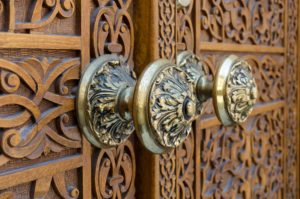
When you’re looking for a new exterior or interior door, whether it’s wood or fiberglass, modern or traditional, we’re convinced you’ll find the perfect match for you and your home at ETO Doors. But after you choose the right door, with the right measurements and configuration, your work isn’t finished. You’ll have to decide on the right hardware.
In door lingo, hardware refers to the metal accessories necessary for the door to function, namely door knobs, door handles, locking mechanisms, and hinges. Here, we’re going to focus on doorknobs and door handles. So let’s go over the various types and styles of doorknobs and door handles, and which ones make the most sense for a given application.
Knobs vs. Handles vs. Levers
Generally speaking, doorknobs are used for interior door applications, like bedroom doors, closet doors, bathroom doors, and the like. Handles, which often feature a trigger-controlled opening mechanism, are normally installed on exterior entryway doors, but can be used for indoor application in certain situations, such as on heavy, opulent master bedroom doors. Turning levers, which are mechanically similar to doorknobs but with greater leverage, are commonly found both on interior and exterior doors. Handles and levers are both more suitable for heavy, secure doors than knobs, because they offer greater leverage to the user.
Functionality: Keyed, Keyless, and Hybrid
Exterior entryway door handles and levers don’t always come attached to a locking mechanism and ready for drop-in installation, but it’s overwhelmingly common to find both matched sets of separate handles and deadbolts, or monolithic handle and lock sets. Full-length sets are similar to monolithic sets, but feature a continuous faceplate connecting the lock and handle, rather than the lock and handle being connected by the handle only, with two separate face plates.
While traditional keyed locks won’t ever go out of fashion, locks are increasingly made available with keyless entry systems. Keyless locks will feature a keypad for passcode entry, and newer, more innovative keyless entry systems function via bluetooth and other wireless technology. Because keys can get misplaced, become warped, or break, keyless entry systems are convenient and largely stress-free in theory.
However, many standard keyless entry systems are entirely contained within your door, with no external power source, leaving them to rely on battery power. While they are mostly power efficient and will not require battery replacement for some time, a dead battery will leave you locked out of your home. Even with a full battery, electrical or mechanical problems may rear their heads, resulting in an inoperable lock. For the best of both worlds, a hybrid locking system featuring both key and keypad is ideal.
Keyless and hybrid locking systems are not commonly installed indoors, since they are intended for increased home security rather than personal privacy. For indoor applications, most standard door knobs and levers will feature an adequate, simple locking system.
Latches: Tubular vs. Mortise
Deadbolt locks are designed in either a tubular or mortise fashion.
Mortise locks are usually found on older doors, in homes and structures built prior to 1950. Mortise locks feature a bulky, block-liked lock body meant to fit into a large recess in the door slab (a mortise). These locks are preferred by those seeking a little more security, but unless a mortise lock is being installed in an older door already suited to receive it, it’s best left to professional installation.
Tubular locks are much more common than mortise locks, representing the majority of locks used in residential entryway doors. Tubular locks are designed for ease of use, with the latch bolt being retracted as the handle or knob is turned. This is the correct option for pre-drilled door slabs, which will almost never be suitable for mortise locks.
Styles
A door handle should be matched to its door by both style and material. In today’s vast hardware market, this is an easy feat; no matter what kind of door you’re working with, you’ll probably be able to find the perfect hardware to bring the whole look together.
Like doors, door handles are marketed in broad categories like rustic, modern, classic, and novelty handles meant to evoke certain themes or cultural aesthetics. An angular, minimalist door slab will likely look best with a similarly minimal handle set, especially one of stainless steal construction. A rustic wood door will probably look best with old-school, even antiquated hardware, provided it meets your security standards. If your door slab features a wrought iron grate, or other iron construction, a heavy iron handle and lock will be a perfect fit.
The right doorknob or door handle will complete the look of your door and compliment your home’s aesthetic; the wrong one will disrupt it. While our selection of hardware is limited, feel free to contact us at ETO Doors for any advice or pointers regarding your door hardware.
 Opanpan Door Skins
Opanpan Door Skins